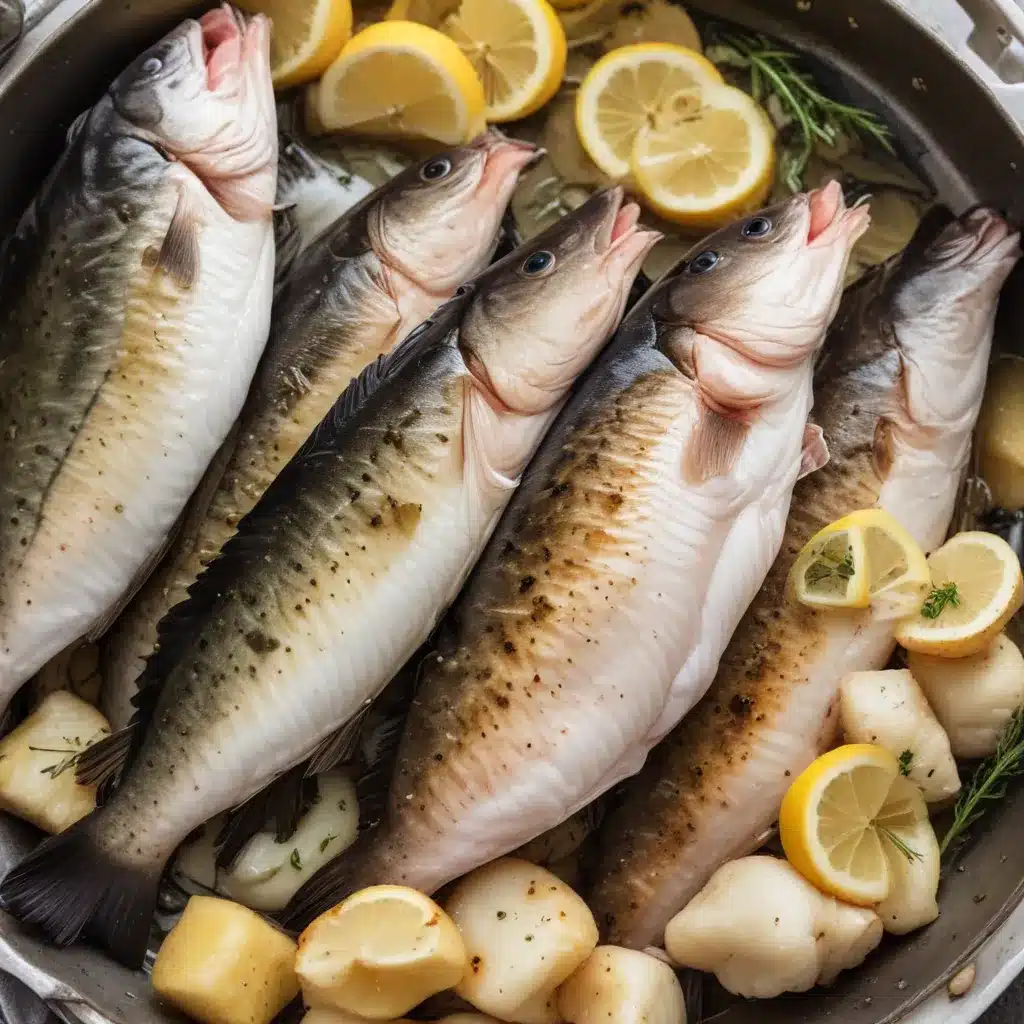
As a seafood dining expert for Fish Tales Cafe, I’m thrilled to share my deep dive into the world of cod – one of the most versatile and beloved fish in the culinary pantheon. Whether you’re a seasoned cook or new to seafood, this comprehensive guide will equip you with the knowledge to source, prepare, and savor the finest cod.
Cod Characteristics
Cod, known scientifically as Gadus morhua, is a truly remarkable fish. With its distinctive olive-green to brown speckled skin and white, flaky flesh, cod is instantly recognizable. But there’s far more to this seafood superstar than meets the eye.
Physical Attributes of Cod
Cod are large, robust fish that can grow up to 6 feet in length and weigh over 100 pounds. Their bodies are elongated with a rounded snout, three dorsal fins, and a single long barbel (whisker-like appendage) dangling from their chin. This unique facial feature helps cod detect prey buried in the seafloor.
Taste and Texture Profiles
The flesh of cod is prized for its delicate, mild flavor and flaky, almost tender texture. When cooked properly, cod develops a lightly crisp exterior while maintaining a moist, delicate interior. The lack of strong “fishy” notes makes cod an incredibly versatile ingredient, pairing well with a wide array of seasonings and cooking methods.
Nutritional Value of Cod
Beyond its culinary appeal, cod is an excellent source of high-quality protein, vitamins, and minerals. A 3.5-ounce serving of cod contains approximately 15 grams of protein, along with generous amounts of vitamin B12, niacin, phosphorus, and selenium. Cod is also low in fat and calories, making it an ideal choice for health-conscious diners.
Cod Varieties
While many people are familiar with the iconic Atlantic cod, there are actually several distinct cod species found in waters around the world.
Common Cod Species
The three main varieties of cod are Atlantic cod (Gadus morhua), Pacific cod (Gadus macrocephalus), and Greenland cod (Gadus ogac). Each type has slightly different physical characteristics and flavor profiles, but all share the distinctive cod traits that make them so prized.
Distinguishing Features of Cod Types
Atlantic cod, the most well-known variety, has a light, flaky texture and a mild, slightly sweet flavor. Pacific cod is slightly firmer in texture with a more pronounced ocean ”taste. Greenland cod, found in the cold waters off northeastern Canada and Greenland, is known for its dense, meaty flesh and slightly briny flavor.
Sustainability Considerations
When sourcing cod, it’s important to consider sustainability factors. Many cod populations have faced challenges due to overfishing, habitat destruction, and climate change. Responsible seafood consumers should look for wild-caught cod from well-managed fisheries, as well as farmed cod raised in environmentally responsible aquaculture operations.
Sourcing Fresh Cod
Selecting the freshest, highest-quality cod is essential for unlocking its full culinary potential. Here’s what to look for when purchasing cod, as well as tips for proper storage and handling.
Identifying Fresh Cod
The hallmarks of fresh cod include a bright, glossy appearance; firm, springy flesh; and a clean, ocean-like aroma. Avoid cod with dull, discolored skin, soft or mushy texture, or a strong, unpleasant fishy odor, as these are signs of deterioration.
Purchasing Cod from Reputable Suppliers
When possible, source your cod from trusted local seafood markets, community-supported fisheries, or online specialty retailers that prioritize sustainability and quality. These purveyors can provide valuable guidance on selecting the best cod and offer insights into the specific sourcing and handling practices that ensure maximum freshness.
Storage and Handling Techniques
For optimal freshness, cod should be stored at 32-35°F in the coldest part of your refrigerator, ideally on a bed of ice. Whole cod or fillets can be kept for 3-5 days when properly refrigerated. Frozen cod, on the other hand, can be stored for several months at 0°F or below. When ready to use, thaw frozen cod in the refrigerator, never at room temperature.
Culinary Applications of Cod
The versatility of cod allows it to shine in a wide variety of culinary applications, from classic preparations to inventive modern dishes.
Cooking Methods for Cod
Cod’s delicate texture and mild flavor make it well-suited for a range of cooking techniques. Baking, broiling, pan-frying, poaching, and steaming are all excellent options that highlight the fish’s natural qualities. More advanced techniques, such as sous vide, en papillote, and ceviche, can also be used to create exceptional cod-based meals.
Complementary Flavors and Pairings
Cod’s mild taste profile means it pairs beautifully with a wide array of seasonings and ingredients. Classic flavor combinations include lemon, herbs (such as dill, parsley, or thyme), butter, and white wine. For a global twist, try pairing cod with Asian-inspired ingredients like ginger, soy sauce, or miso, or with Mediterranean flavors like tomatoes, olives, and capers.
Cod-Based Dish Inspiration
The culinary possibilities with cod are endless. Classic preparations like fish and chips, baked cod with lemon and breadcrumbs, and cod chowder showcase the fish’s versatility. More innovative dishes, such as cod cakes with remoulade, cod ceviche with citrus and avocado, or cod en papillote with Mediterranean vegetables, can delight the senses and impress your guests.
Whether you’re a seasoned seafood enthusiast or new to the world of cod, this comprehensive guide has provided you with the knowledge and inspiration to source, prepare, and enjoy this remarkable fish. Elevate your culinary experiences by embracing the versatility and freshness of cod, and discover why it remains a beloved staple in kitchens and restaurants around the world. For more seafood insights and recipes, be sure to visit Fish Tales Cafe.

